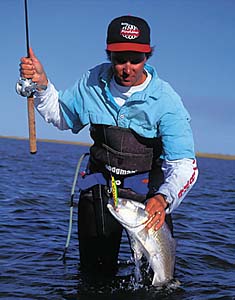Winter Wading
By Buddy Gough
Page 2
 About three days after meeting Houston, I talked to another bayfront
fan-fishing guide Doug Bird. On a day when a break in the cold
front brought sunshine and light winds, Bird spoke of taking a
limit of trout off the mainland shoreline that morning. About three days after meeting Houston, I talked to another bayfront
fan-fishing guide Doug Bird. On a day when a break in the cold
front brought sunshine and light winds, Bird spoke of taking a
limit of trout off the mainland shoreline that morning.
While he didn't think the afternoon bite would be as productive,
he was willing to lead a show-and-tell in the name of bayfront
education. This involved launching from the convenient boat ramp
at the downtown "L Head" on Shoreline Drive and motoring
a few hundred yards to fish the rock breakwaters guarding the
harbor.
Like Houston, Bird had learned the ways of the bayfront from
an old timer many years ago. He had started out casting lures
from the downtown seawall during winter lunch breaks. The brief
afternoon foray on the rocks produced only a half-dozen specks,
but the trip was a case where the guide's informative words spoke
louder than the action.
Bird provided another lesson in bayfront fishing Wednesday afternoon.
This time the focus was on a stretch of shoreline on Ocean Drive
between Doddridge and Robert Streets. Among bayfront anglers,
the area was near the so-called "S Curve" north of Doddridge.
As one of the most productive fishing areas along the bayfront,
the S Curve offers surf-like terrain of alternating shallow sand
bars and deeper guts, as well as grass beds and piers.
The mode of operation Wednesday involved personal platform floats
powered by a pair of flippers. Whether store-bought or homemade,
the small float "boats" represent a common conveyance among
the dedicated contingent of bayfront anglers.
Bird had a top-of-the-line Hobie Float Cat. His companion, Boyd
Hinton, had a vintage "Water Wagon" from the 1960s. I was
also outfitted with Water Wagon and a pair of swim fins, and proceeded
to go around in circles for the next two hours. Casting and maneuvering
the float simultaneously was like trying to walk and chew gum
at the same time-seemingly impossible at first.
By the time float and flippers were looking like an ideal way
to fish the shoreline, Bird had already caught and released 14
specks to 21 or 22 inches. Hinton also had good action.
Fishing with Bird also brought to mind an earlier trip with fishing
guide Don Hand of Corpus Christi. Although Hand now makes a living
guiding the Laguna Madre, he was first lured to the Coastal Bend
by its wealth of foot-accessible wade fishing opportunities. He,
too, learned winter hotspots along the Corpus Christi bayfront.
One favorite is Indian Point on the Nueces Bay Causeway, a couple
of miles from city center. The point is best known for Indian
Point Pier, which has long been known as one of the better fishing
piers in the Coastal Bend. Hand, however, knows the point as prime
place for winter wading.
On the south side of the point, the water drops off deep toward
the opening between Corpus Christi Bay and Nueces Bay. On the
north side of the point is a shoreline "beach" of bars and
guts of hard-packed sand. In other words, it's a good place for
trout to move in and out of as water temperatures rise and fall.
On a sunny day after a norther, Hand parked at a parking lot
at the foot of Indian Point Pier and waded into the shallows about
150 yards north of the piers. He crossed two bars and guts to
reach the top of the third bar in chest-deep water, where nearly
a dozen fishermen were strung out in a line.
Casting MirrOlures, we proceeded to string a limit of trout and
release a number of others. Just about everybody in line had a
limit.
Hand said the location was known to produce large trout on occasion.
Another of Hand's favorite locations is the Oso Bridge-Naval
Air Station (NAS) area at the south end Ocean Drive. The mile-long
area has two distinct features. At the Oso Bridge is the opening
between the shallows of little Oso Bay and the deep waters of
Corpus Christi Bay. It's a natural fish pass.
Another thing to know about Oso Bay is that it receives the warm
water discharge from the Central Power and Light Plant in Flour
Bluff. Thus, the Oso waters flowing into Corpus Christi Bay can
be a few degrees warmer-a fact that trout appreciate in the winter.
The second distinctive feature is a series of bars and guts running
parallel to the shore between the Oso Bridge and the NAS. There
are as many as four wadeable sand bars reaching out from shore
with shell in the guts between. Hand said the area has the same
things going for it as the Indian Point area.
From talking to and fishing with some the experts, the following
tips for fishing the bayfront were gleaned:
 Best Lures Best Lures
MirrOlures, especially the 51 Series in chartreuse color patterns.
Other choices include dark-colored soft plastics, as well as silver
and gold spoons.
Best Conditions
Light or moderate winds with relatively calm and clear waters.
Warming trends with sunny skies after a cold front are usually
best, but cloudy and cool conditions early in a front can also
be good.
Best Laid Plans
Scout accessible areas during calm periods of clear water and
low tides to spot and pinpoint the bars, guts, holes and other
fish-holding structure. Be particularly alert for storm drains
emptying into the bay. The wash-out from these drains creates
cuts and holes in which trout gather.
Best Advice
Get to know a bayfront regular.
# # # #
page 1 / page 2
| 




